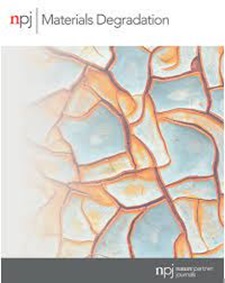奥氏体不锈钢和镍基焊接接头在水下湿焊中的腐蚀行为
IF 7.6
2区 材料科学
Q1 MATERIALS SCIENCE, MULTIDISCIPLINARY
引用次数: 0
摘要
港口、桥梁、管道、船舶和平台等海洋结构是现代基础设施的重要组成部分,使用强度更高的钢材可以节省物流和施工成本。然而,高强度钢的维修具有挑战性,尤其是在水下。湿式金属保护弧焊是水下焊接修复中应用最广泛、成本最低的方法,但非常容易出现氢致裂纹。因此,研究人员和焊接工程师致力于减少焊接材料中的氢含量。最近取得成功的方法是使用奥氏体焊材,如奥氏体不锈钢和镍基电极。这些焊材的使用大大减少了焊接金属中可扩散氢的含量。然而,这些奥氏体材料的腐蚀潜能通常与焊珠所适用的结构钢不同。这就产生了严重的电化学腐蚀风险。本研究对使用奥氏体不锈钢和镍基电极制造的焊缝的腐蚀行为进行了研究。样品在波罗的海中老化了 1.5 年。与此同时,还对涂层和冲击电流阴极保护(ICCP)等腐蚀保护系统的有效性进行了评估。在腐蚀环境中使用奥氏体电极时,热影响区会发生局部腐蚀。在波罗的海和盐雾层中使用 1.5 年后,局部腐蚀深度分别约为 250 微米和 390 微米。ICCP 系统和涂层的使用有效地防止了局部腐蚀。根据标准,2.5 × 103 m-2 的低点蚀密度相当于 A1 级,与热影响区的局部腐蚀相比可以忽略不计。本文章由计算机程序翻译,如有差异,请以英文原文为准。

Corrosion behavior of austenitic stainless steel and nickel-based welded joints in underwater wet welding
Marine structures such as ports, bridges, pipelines, vessels, and platforms are an essential part of modern infrastructure, where the use of higher-strength steel provides savings in logistics and construction. However, the repair of higher-strength steels can be challenging, especially underwater. Wet shielded metal arc welding is the most widely used and least expensive method for underwater welding repairs, but is very susceptible to hydrogen-induced cracking. Thus, researchers and welding engineers aim to reduce the amount of hydrogen in the weld material. Recent success has been achieved through the use of austenitic welding consumables, such as austenitic stainless steel and nickel-based electrodes. The use of these consumables drastically reduces the amount of diffusible hydrogen in the weld metal. However, these austenitic materials usually have different corrosion potential as compared to the structural steel the weld beads are applied to. This creates the risk of severe galvanic corrosion. In the presented study, the corrosion behavior of welds created with austenitic stainless steel and nickel-based electrodes were studied. Samples were aged for 1.5 years in the Baltic Sea. Simultaneously, the effectiveness of corrosion protection systems such as coating and Impressed Current Cathodic Protection (ICCP) were evaluated. Localized corrosion occurred in the heat-affected zone when austenitic electrodes were used in the corrosive environment. The localized corrosion depth after 1.5 years in the Baltic Sea and in the salt spray layer was approximately 250 µm and 390 µm, respectively. The ICCP system and the use of a coating were effective in preventing localized corrosion. The low pitting corrosion density of 2.5 × 103 m−2 corresponds to grade A1 according to the standard and was found to be negligible as compared to the localized corrosion in the heat-affect zone.
求助全文
通过发布文献求助,成功后即可免费获取论文全文。
去求助
来源期刊

npj Materials Degradation
MATERIALS SCIENCE, MULTIDISCIPLINARY-
CiteScore
7.80
自引率
7.80%
发文量
86
审稿时长
6 weeks
期刊介绍:
npj Materials Degradation considers basic and applied research that explores all aspects of the degradation of metallic and non-metallic materials. The journal broadly defines ‘materials degradation’ as a reduction in the ability of a material to perform its task in-service as a result of environmental exposure.
The journal covers a broad range of topics including but not limited to:
-Degradation of metals, glasses, minerals, polymers, ceramics, cements and composites in natural and engineered environments, as a result of various stimuli
-Computational and experimental studies of degradation mechanisms and kinetics
-Characterization of degradation by traditional and emerging techniques
-New approaches and technologies for enhancing resistance to degradation
-Inspection and monitoring techniques for materials in-service, such as sensing technologies
 求助内容:
求助内容: 应助结果提醒方式:
应助结果提醒方式:


